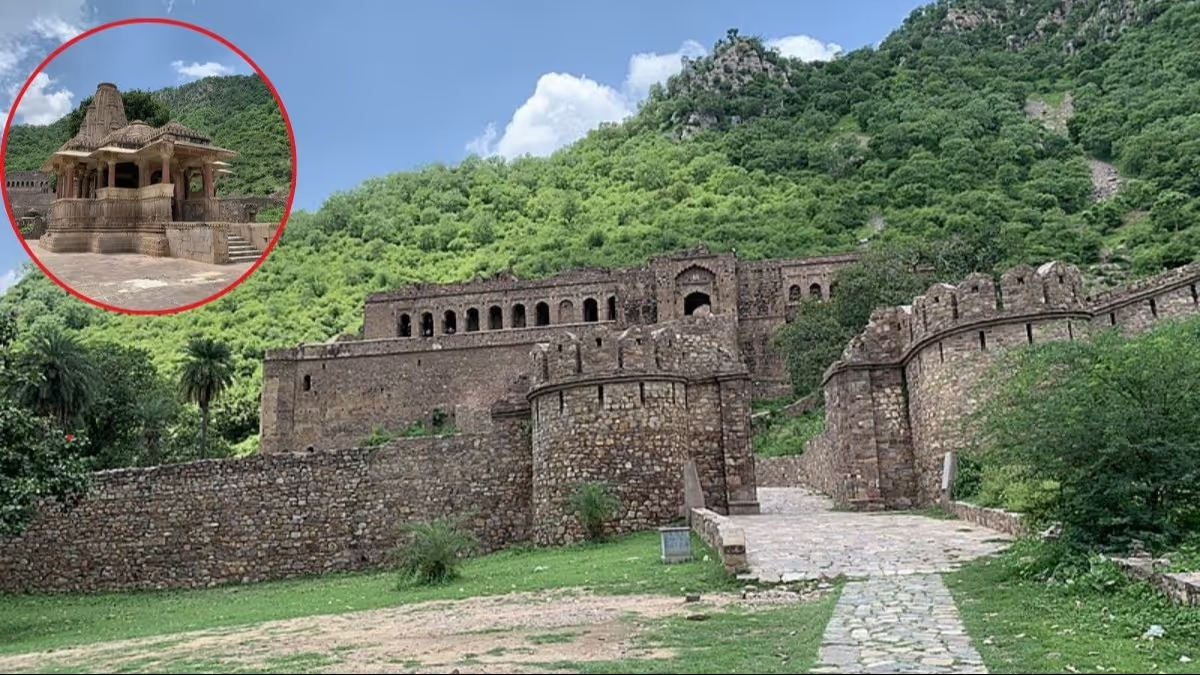Jaipur News Desk !!! Jantar Mantar in Jaipur is an astronomical observatory built by Sawai Jai Singh between 1724 and 1734. It is included in the UNESCO ‘World Heritage List’. This observatory has 14 major instruments which are helpful in measuring time, predicting eclipses, knowing the speed and position of a star, knowing the position of the planets of the solar system, etc.
Attached to the old royal palace ‘Chandra Mahal’ in Jaipur is an astonishing medieval achievement – Jantar Mantar! Famous all over the world for analyzing and accurately predicting astrological and astronomical phenomena through ancient astronomical instruments and complex mathematical structures, this unique observatory was built in 1728 under the personal supervision of the founder of Jaipur city, King Sawai Jai Singh (II) of Amer. Construction was started in 1734. Sawai Jai Singh was also an astronomer, whose contribution and personality have been reverentially praised by Jawaharlal Nehru in his famous book ‘Discovery of India’ (‘Bharat: Ek Khoj’). Before the construction of this observatory, Sawai Jai Singh sent his cultural emissaries to many countries of the world and brought manuscripts of ancient and important texts of astronomy from there and preserved them in his Pothikhana (library) and also translated them for his study. Maharaja Sawai Jai Singh II built five observatories across the country based on Hindu astronomy. These observatories were built in Jaipur, Delhi, Ujjain, Banaras and Mathura. In the construction of these observatories, he took the help of eminent astronomers of that time. First, Maharaja Sawai Jai Singh (II) built Samrat Yantra in Ujjain, then Observatory (Jantar-Mantar) in Delhi and ten years later Jantar-Mantar in Jaipur. Jaipur Observatory is the largest among the five observatories of the country. The construction of this observatory started in 1724 and the construction work was completed in 1734. Out of the five observatories built by Sawai Jai Singh, today only Jantar-Mantar of Delhi and Jaipur are left, the rest have been lost to the jaws of time.
On 1 August 2010, UNESCO announced the inclusion of seven monuments around the world including Jantar Mantar in the “World Heritage List”, which also includes Jaipur’s Jantar Mantar in the World Heritage Monument category in the 34th International Conference of UNESCO. The main reason given for this honor was that despite so many years having passed, all the ancient instruments of this observatory are still in good condition; through which even today accurate calculations of weather, local time, planets-stars and astronomical events like eclipses can be done. Jantar Mantar located in Jaipur received the status of World Heritage in 2010. Jantar Mantar is the first cultural heritage site of Rajasthan and the 23rd cultural heritage site of India whose name has been included in the World Heritage List. Maharaja Sawai Jai Singh II is credited with the creation of a unique heritage of history.
This monument has been included in the World Heritage List, considering the Indian science of studying astronomical phenomena through instruments made of wood, lime, stone and metal 282 years ago as ‘amazing’. Even today, the local Panchang of Jaipur is published on the basis of the calculations of these instruments and every year on Ashadh Purnima, the upcoming rain is predicted by astronomers through the ‘Pawan Dharana’ process. Among the instruments here – ‘Samrat-Yantra’ (which is a huge sundial), ‘Jaiprakash-Yantra’ and ‘Ram-Yantra’ are the most famous, of which ‘Samrat-Yantra’ is the tallest (about 90 feet high from the ground), through which the time can be told with sufficient accuracy.
Jantar Mantar has become the first monument of Rajasthan state and the 28th monument of the country to be included in the World Heritage List. Bharatpur’s dense bird sanctuary is already included in the UNESCO World Heritage List in the cultural category. This will not only give a new international identity to this unique observatory, but will also provide a separate fund of 40 thousand dollars for the maintenance of the monument. The major instruments located in Jantar Mantar of Jaipur are – Brihat Samrat Yantra, Laghu Samrat Yantra, Jaiprakash Yantra, Ram Yantra, Dhruv Yantra, Dakshin Yantra, Nadivalaya Yantra, Rashi Valaya, Disha Yantra, Laghu Kranti Yantra, Hridaya Kranti Yantra, Raja Yantra, Untanamsha Yantra, and Digamsha Yantra. Apart from these, instruments like Krantivritt Yantra, Yantraraj etc. were also used here for important astrological calculations and astronomical markings.
altitude instrument
Just to the left of the entrance of Jantar Mantar, a huge metal ball hangs between two pillars on either side of a circular platform known as Unnatamsha Yantra. This instrument was used to measure the altitude and angular height of objects in the sky.
Dakshinodaka Financial Instrument
To the east of Unnatamsha Yantra is a walled building called Dakshinodata Vitiyaranta extending from north to south directions. The front part of the wall has stairs on both sides which lead to the upper part of the wall. While the surface of the wall is flat. This instrument was used to know the height of the sun in the middle of the day and the revolution of the sun and day through them.
Direction Device
This is a simple instrument. In the center of the Jantar Mantar complex, there is a huge circle made of red stone on a large square flat ground and a right-angled cross is made in all four directions from the center. This is a compass instrument that generally gives knowledge of directions.
Samrat Yantra
The biggest instrument in Jantar Mantar is Samrat Yantra. It was called Samrat Yantra due to its grandeur and glory. The grandeur of the instrument can be estimated from the fact that the height of its top from the ground is 90 feet. There is also an umbrella on the top of Samrat Yantra. This instrument was established for the knowledge of the revolutions of the planets and stars, equinoxes and time.
Sixth instrument
Shashtamsha Yantra is a part of Samrat Yantra. This annular instrument in the shape of moon is situated in the east and west direction from the base of Samrat Yantra. This instrument was also used to know the position and degrees of planets and constellations.
Jai Prakash Yantra
Jai Prakash instruments were invented by Maharaja Jai Singh. The design of these bowl-shaped instruments is unmatched. These instruments are located between Samrat Yantra and Disha Yantra in the Jantar Mantar complex. In these, the edge was considered as the horizon and astronomical observation of half of the sky was done for the knowledge of each object. Along with this, the position of the sun in any zodiac sign is also known from these instruments. Both these instruments complement each other.
pulse ring device
This instrument is located on the right side of the entrance. It is divided into two circular faces. The position of the sun and the local time can be accurately estimated from the various lines drawn around its centre point.
Polaroid plaque
Polaris is a simple instrument used to find the position and direction of the Pole Star. This wall-like slab is raised from south to north in the north-south direction. Looking at its southern end makes the position of the Pole Star at the northern end clear.
Miniature Emperor Yantra
Laghu Samrat Yantra is the instrument located to the west of the polar viewer plate. It is also called a sun clock. This instrument calculates the local time accurately. Made of red stone, this instrument is a smaller version of the Samrat Yantra, hence it is known as Laghu Samrat Yantra.
Horoscope
Their number is 12 which represents the 12 zodiac signs. The special feature of these twelve instruments is their design, which shows the position of each zodiac sign and the planets located in them. All these instruments are similar in appearance but the structure of these instruments showing the position of the zodiac signs in the sky is different.
Chakra Yantra
Consisting of two huge iron wheels, these instruments were used to measure the declination of celestial bodies and the instantaneous geographical coordinates. It is located to the north of the Zodiac instrument.
Ramyantra
Ram Yantra has panels of degrees drawn from the centre to the centre of the circles of the pillars. Important astronomical calculations were also done with these tablets. Ram Yantra is one of two instruments located near the western wall of Jantar Mantar. Two miniature versions of these instruments are also located near these instruments in Jantar Mantar.
Azimuth instrument
This device was used to determine the azimuth of objects. The azimuth is located near the exit door. This device is made in the form of small circles in a circular wall.
Raj Yantra
Accurate information is still available today The instruments installed in this observatory are Samrat, Jaiprakash and Ram Yantra, of which Samrat Yantra is the largest which is used for air testing. The height of Samrat Yantra is 140 feet, the celestial pole is marked on its top, as well as time marks which even today give accurate information of hours, minutes and quarter minutes.





